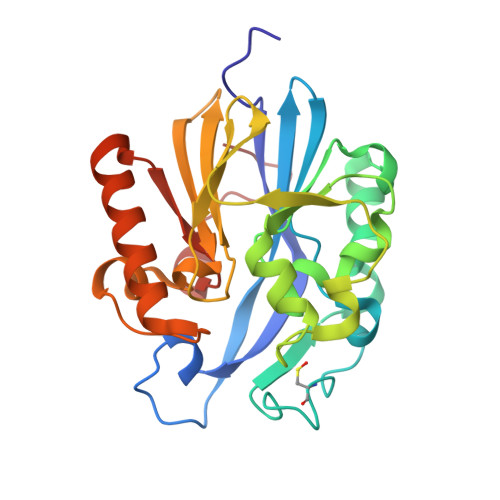Conformational Tinkering Drives Evolution of a Promiscuous Activity through Indirect Mutational Effects.
Yang, G., Hong, N., Baier, F., Jackson, C.J., Tokuriki, N.(2016) Biochemistry 55: 4583-4593
- PubMed: 27444875
- DOI: https://doi.org/10.1021/acs.biochem.6b00561
- Primary Citation of Related Structures:
5EH9, 5EHT - PubMed Abstract:
How remote mutations can lead to changes in enzyme function at a molecular level is a central question in evolutionary biochemistry and biophysics. Here, we combine laboratory evolution with biochemical, structural, genetic, and computational analysis to dissect the molecular basis for the functional optimization of phosphotriesterase activity in a bacterial lactonase (AiiA) from the metallo-β-lactamase (MBL) superfamily. We show that a 1000-fold increase in phosphotriesterase activity is caused by a more favorable catalytic binding position of the paraoxon substrate in the evolved enzyme that resulted from conformational tinkering of the active site through peripheral mutations. A nonmutated active site residue, Phe68, was displaced by ∼3 Å through the indirect effects of two second-shell trajectory mutations, allowing molecular interactions between the residue and paraoxon. Comparative mutational scanning, i.e., examining the effects of alanine mutagenesis on different genetic backgrounds, revealed significant changes in the functional roles of Phe68 and other nonmutated active site residues caused by the indirect effects of trajectory mutations. Our work provides a quantitative measurement of the impact of second-shell mutations on the catalytic contributions of nonmutated residues and unveils the underlying intramolecular network of strong epistatic mutational relationships between active site residues and more remote residues. Defining these long-range conformational and functional epistatic relationships has allowed us to better understand the subtle, but cumulatively significant, role of second- and third-shell mutations in evolution.
Organizational Affiliation:
Michael Smith Laboratories, University of British Columbia , Vancouver, BC V6T 1Z4, Canada.

















